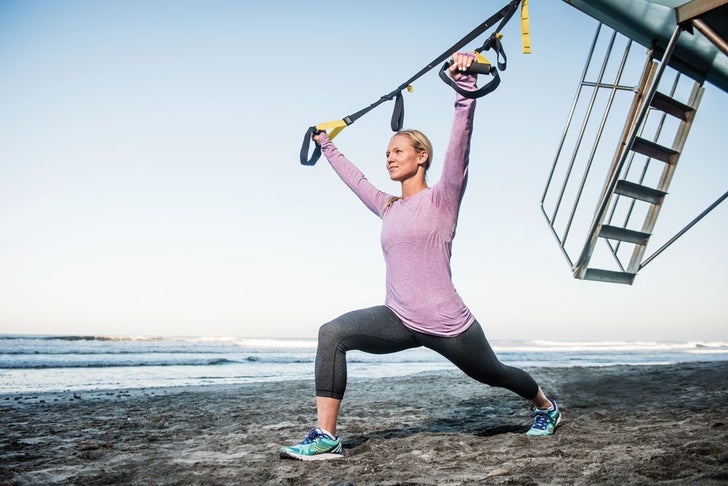The second Grand Slam event of the year, the French Open marks the beginning of the summer season for tennis. The significance of the clay surface (versus, say, grass) gives an advantage to better conditioned players, instead of just the best hitters.
When talking tennis training and conditioning, the TRX Suspension Trainer has become the go-to tool for tennis greats from Max Mirnyi, Kevin Anderson, James Blake and Melanie Oudin. With it, tennis athletes can improve on-court performance and reduce the chance of overuse injuries. Want to find the perfect tennis-specific exercises for your game? Take our quick assessment quiz to get personalized TRX training recommendations matched to your skill level.
TAKE OUR TRAINING QUIZ
Here, TRX Instructor Anne Parker and physical therapist Patty Pennell demonstrate four TRX Suspension Training exercises that will improve core stability, hip mobility and rotational strength for improved on-court performance.
TRX Lunge (with Medicine Ball)
Benefits: Improves hip mobility, stability and rotational strength and builds power in the front leg
Adjust your TRX to the fully lengthened position and place it into single handle mode. Stand facing away from the anchor point and place your left foot in the TRX foot cradles with your weight on your right foot about 12 inches in front and to the right of the anchor point. Bend your front leg to 90 degrees, keeping your left leg aligned with the anchor point. At the same time, reach first down with your medicine ball and then, as you drive up with your right left, reach up and to the right with the medicine ball. This is one rep. Repeat the exercise for 10 reps before switching legs.
TRX Grappler Push/Pull
Benefits: Increases upper body rotational strength and shoulder stability
Adjust your TRX to the mid length position, take it out of single handle mode and stand facing sideways to the anchor point. Begin by aligning your hands (with bent elbows) in front of the anchor point. Allow your body to move away from the anchor point by straightening your arms. Ensure your body remains in a strong plank; do not allow your hips to sag during the movement. Return to an upright standing position with straight arms. Repeat for 10 reps before switching sides.
TRX Crossing Balance Lunge (with Hop)
Benefits: Increases hip strength and foot speed as well as power for backhand and forehand swings
With your TRX still in the mid length position, stand facing the anchor point with your feet together. While holding onto the TRX, hop your right foot back and behind you into a lunge position and quickly switch legs, repeating the movement by hopping your left leg back and behind you. Repeat for 10 reps, alternating legs each time. Perform the movement again, this time hopping your legs to the front. Repeat for 10 reps, alternating legs each time.
TRX Forward Lunge
Benefits: Improves hip mobility, stability and rotational strength and builds power in the front leg
Adjust your TRX to mid calf position. Place your left hand in the foot cradles and stand facing away from the anchor point. Step forward with your right foot into a lunge position; your knee should not go beyond 90 degrees. Simultaneously raise your left hand, maintaining tension on the TRX, until you feel a stretch. Drive up and back with your right foot and lower your arm as you return to start position. Repeat the exercise for 10 reps before switching sides.
The physical demands of tennis can take a toll on your joints if you don’t train to play. Putting some time into your off-court training program using the TRX will improve your rotational strength, multi-directional running, muscular endurance and power for your serve. In short, it will take your tennis conditioning to the next level! See you on the court.
Anne Parker, CSCS, is a TRX Instructor and a strength and conditioning coach and speaker who motivates and educates athletes throughout the US. She is the creator of Train to Run and Train to Play workshops, teaching athletes how to train for injury prevention and improved performance.
Dr. Patty Pennell-Noel, PT, ScD, is the owner of Back to Motion Physical Therapy in Denver, Colorado. Patty is currently a physical therapist for the Women’s Tennis Association (WTA) and also serves as a consultant for the Leukemia Team in Training. Aside from her private practice, Patty works as clinical faculty for Regis University’s Physical Therapy Program in Denver.
For a comprehensive, real-time tennis workout, check out the TRX Performance: Tennis DVD in the TRX shop.



